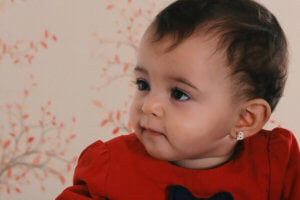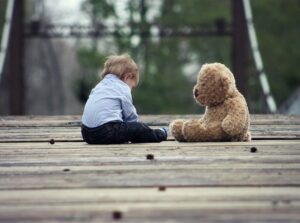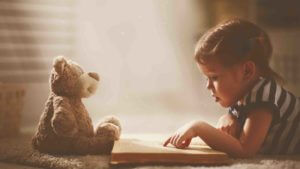Table of contents
Growing Up While Sleeping
Sleeping is by no means – as many believe – an uneventful, boring process, but a source of health and well-being. For children, an undisturbed night’s rest is especially important so that they can grow and learn – because that happens, so to speak, while they sleep!
Leaving the day behind, resting, gathering new strength – to stay healthy, we need sufficient sleep on a regular basis. Not only the body needs to regenerate, but also the consciousness needs its time out. During sleep, therefore, three different sleep stages alternate several times: from the first, light sleep, we first sink into deep sleep. But after less than an hour, we return to the surface and begin to dream. Researchers have named this third phase after the rapid eye movements that can be observed under the closed eyelids: the REM phase (rapid eye movements). After the first dream phase is over, we fall back into deep sleep. In one night, we thus go through four to five sleep cycles until we wake up in the morning.
- Also interesting:
- The best burglar-proof doors
- Recommended jumping jacks for children
- The best RC buggies for children
Sleep And Grow
Deep sleep is primarily for physical rest – this is the same for both children and adults. While we sleep, the pituitary gland releases more growth hormones, which repair damaged cells and create new ones.
But children now also gain length: most of their growth takes place during deep sleep. This is why children need more sleep than adults. Only a child who regularly gets enough sleep can develop in a physically healthy way.
Depending on the age of your baby, sleep times are quite different. A newborn child up to 3 months can sleep up to 17 hours a day. Children 12 months and older can still sleep up to 14 hours a day.
Intelligent Sleep
While adults get by with short REM phases during sleep, children spend up to 50 percent of their sleep time in the dream stage. Sleep researchers have found that brain development occurs predominantly in this stage: Nerve cells emerge and become interconnected through what are known as synapses, and the most important brain functions are laid out…. The younger a person is – the more immature his brain – the more time he spends in REM sleep. But the brain does even more in the dream phase. This is because it now processes all the experiences and learning content, movement and sensory experiences that the child has collected as “building materials” during the day. At night, the brain assembles them into fixed memory content, deletes unusable memories, links individual building blocks with earlier experiences and transports information from short-term to long-term memory. What has been learned is consolidated – the child becomes smarter in his sleep, so to speak! Many adults will know this as well: Sleeping can be an extremely creative process, in that the new connections in the brain at night suddenly give rise to ideas that did not occur to them during the day. There is also some truth in the saying that you have to sleep on some things for another night.
What Do Children Dream About?
Although sleep researchers have already discovered a lot about the function of REM sleep, the world of dreams is still largely unexplored. The latest theories suggest that dreams are a chaotic discharge of brain waves in which images of previously experienced situations randomly appear and are linked to memory content. By the way, nature has arranged it in such a way that the muscles of our limbs are powerless and immobilized during dreaming. Thus, we cannot unconsciously act out what we dream and endanger ourselves or others.
Children dream mainly of animals, of powerful forces such as magic, of flying, or of current play situations that they process in their sleep. Fairy tales and stories that they have heard or seen on television also occupy them during the night. However, many impressions still have a fear-inducing effect on children because they have less experience than adults. They are therefore more often plagued by bizarre and “bad” dreams. They sometimes wake up in the night screaming and crying and do not know what has happened. However, such nightmares are normal in childhood and do not cause further concern. However, parents should remember that frightening experiences may have been the trigger – perhaps a scary fairy tale or overly exciting television images. The important thing now is for parents to reassure their child that nothing can happen to him or her as a result of a bad dream. This is because younger children in particular still think their dreams are real. It is not until school age that most children have understood that dreams are dreams.
When the dear little ones don’t want to fall asleep, it drives many parents to despair. – Rituals that you start together from a very young age at bedtime can help to manage falling asleep without problems:
- Lullabies – sing a lullaby to your baby.
- Take a long walk before bedtime – oxygen makes you tired.
- A lap around the house – say goodbye to siblings and toys and say good night.
- Good night story: children who know this ritual from an early age fall asleep wonderfully.
- Favorite cuddly toy always with you when falling asleep.
Rituals help to increase well-being, convey safety and security and thus help the little one to fall asleep faster.
Tip: Favorite Cuddly Toy In Multiple Versions
A good tip is to buy cuddly toys in multiple versions. Often small babies already have an absolute favorite cuddly toy and since this sometimes has to go into the washing machine, or you can lose it on a walk, forget it at grandma and grandpa’s, you should always have an equal replacement in stock. – Best from the beginning always the 2-3 same cuddly toys aufwechseln, so they wear out right away and the critical offspring, the replacement will not stand out as such.












